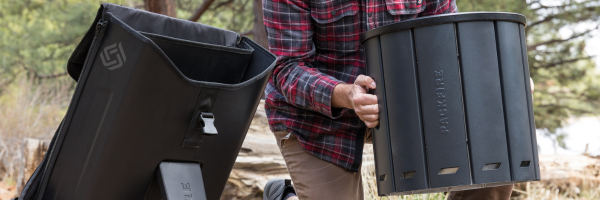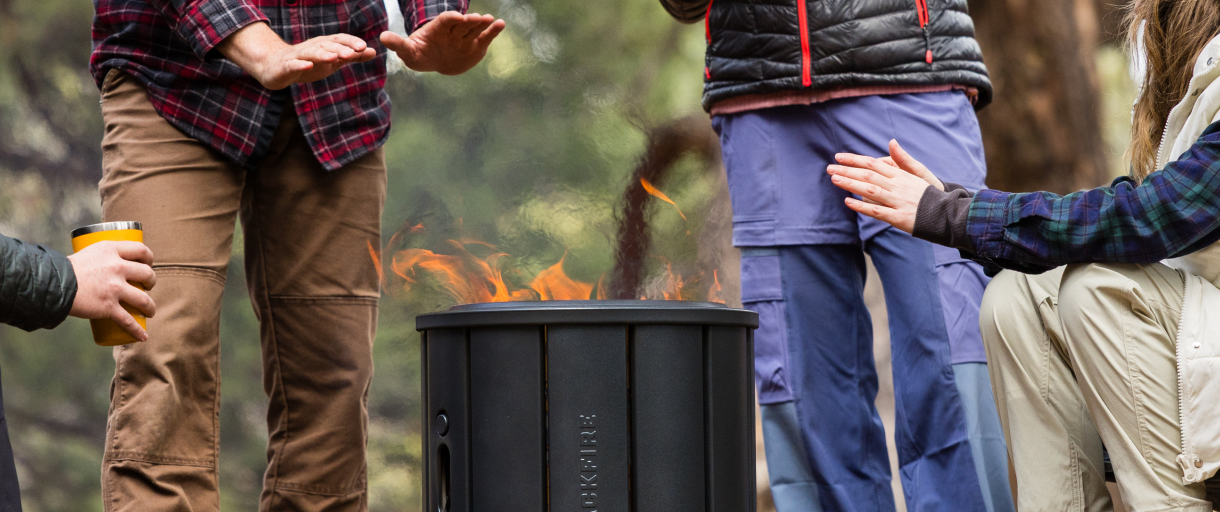PACKFIRE Blog
Best Firewood for Fire Pit: Expert Tips for Flames That Last
You’ve set up your outdoor fire pit, maybe even your portable PACKFIRE fire pit on your first night of camp, and you’re ready for that perfect crackle and glow. But the logs you throw in, well, they matter more than most people realize.
Different types of wood behave uniquely. Some give instant flame but burn too fast. Some smoke so much that it ruins your cozy evening. While seasoned hardwoods are typically the best choice, choosing the right wood for your fire pit is also a matter of preference. Now let’s find the best firewood!
Key Takeaways
-
Seasoned hardwoods provide long burning time, steady heat output, and clean flames.
-
The “best” firewood is based on density, bark, knots, and airflow.
-
Avoid green wood or freshly cut logs contain high moisture, which produces excess smoke and reduces burn efficiency.
-
Certain softwoods ignite fast but can leave a residue; pairing them with hardwoods balances burn time and heat output.
-
Avoid treated woods. They can release toxic fumes and ruin your evening.
-
Proper stacking, airflow, and even log rotation can enhance the performance of burning wood, especially in portable setups like PACKFIRE’s smokeless fire pit.

What Makes Firewood “Best” for Your Fire Pit?
Not all wood is created equal. The right logs affect flame quality, heat output, and overall experience, and some characteristics are easy to overlook until you’ve spent a night waving away smoke. So before you grab the first bag of wood you see, the “best” is based on two things.
#1 Wood Density
Dense woods store more energy, resulting in longer-lasting flames and a more consistent heat output. Even if it takes a little extra time to ignite, the fire rewards patience with long burning time and minimal smoke. Lighter woods burn fast, which is fine for starting a fire, but they can leave your pit needing more fuel sooner than you’d like.
#2 Bark, Knots, and Airflow
The shape and texture of logs matter more than most realize. Rough bark edges and small knots create natural air channels, improving combustion. This subtle airflow adjustment can help burning wood ignite faster, burn cleaner, and produce a steadier flame without requiring constant log repositioning.
Hardwoods vs Softwoods
-
Hardwoods like oak, hickory, and maple are dense and strong. They have long burning times, high heat output, and minimal smoke. The trick professionals use: stack hardwoods with the bark facing outward to promote slower burn and more radiant heat.
-
Softwoods, such as pine or cedar, ignite quickly but produce a lot of smoke and leave more creosote (a flammable, tar-like, dark residue). Experts often use them only to start fires or as a thin “cap” layer over kindling to boost ignition.
PACKFIRE Pro Tip: Mixing softwoods and hardwoods strategically can give you both a fast-starting flame and a clean-burning, long-lasting fire. Think of softwoods as the starter and hardwoods as the main course.
Understanding Wood Moisture and Green Wood
Here’s something not everyone knows: even hardwood vs softwood comparisons can be misleading if you ignore moisture. Freshly cut or green wood (timber that has been recently felled and still contains a high amount of natural moisture) can have up to 50% water content. It’s inefficient, and it literally steals heat energy.
Instead of your fire radiating warmth, energy is spent evaporating water. The result? Smoke everywhere, longer ignition time, and logs that burn quickly and unevenly.
PACKFIRE Pro Tip: Store wood on a raised rack with airflow underneath and loosely stacked. Cover the top to protect from rain, but leave the sides open. This helps wood dry evenly and reduces problems with high moisture content, which can shorten burn time.
Specialty Firewoods You Might Not Know About
Some woods have secret benefits that seasoned fire pit users swear by:
-
Fruitwoods (apple, cherry, pear): Sweet aroma, moderate burn time, perfect for roasting marshmallows without overpowering smoke.
-
Hickory: Dense, high heat output, long-lasting. A favorite for overnight fires in colder conditions.
-
Maple & Oak: Reliable, evenly burning, produces less smoke, easy to stack for portable pits.
-
Beech or Ash: Surprisingly fast to light if appropriately seasoned, burns cleanly, and has a very steady flame—great for late-night stories.
PACKFIRE Pro Tip: Hardwood logs with slightly rough bark edges create micro-air channels, naturally boosting airflow and improving combustion in wood-burning fire pits (which means less smoke and hotter fires!). It’s subtle but makes a difference in flame consistency.
Wood You Should Not Burn in a Fire Pit
-
Treated woods: Those scrap pieces of wood from your recent home renovation project? They release toxic fumes. Never burn them!
-
Painted lumber or plywood: Toxic and unpredictable. They might ruin your pit… and your night.
-
Overly wet logs: Not only smoky, but they can also pop and spit embers unpredictably.
Pro Tip: Professionals often test firewood for hidden moisture by tapping two logs together. A hollow sound usually indicates properly seasoned wood. A dull thud? It’s still too wet.
Wood Storage Secrets for Maximum Efficiency
Even seasoned wood can fail if stored poorly:
-
Stack your wood on a raised rack for airflow underneath.
-
Lean logs slightly to allow air circulation and prevent rolling.
-
Cover the top with a waterproof tarp, leaving the sides open.
-
Rotate older logs to the front for usage, ensuring seasoned wood is always ready.
PACKFIRE Pro Tip: Rotate logs after splitting; wood dries differently in different seasons. This subtle step balances moisture and ensures your logs ignite evenly. You can find out more about lighting a fire in a fire pit here!

FAQ on Wood for Fire Pits
What is the best wood for fire pits?
Seasoned hardwoods like oak, hickory, and maple provide long burning time, high heat output, and minimal smoke.
Can I burn softwood in my fire pit?
Yes. Softwoods ignite quickly, are ideal for kindling, but can produce a lot of smoke and burn more rapidly than hardwoods. They are better as fire starters before moving onto hardwood.
Why shouldn’t I use green or freshly cut wood?
High moisture content reduces heat, increases smoke, and shortens burn time. They might even cause spitting fire embers, which can be a fire hazard. Always let wood dry before use.
Is treated wood safe to burn?
No. Treated woods or painted lumber release toxic fumes, which can impact your health.
How should I store firewood?
Stack wood loosely for airflow, and cover the top, with the sides open. Rotate older logs forward to ensure seasoned wood is ready to spark up your next fire.
Final Thoughts on Best Firewood for Fire Pits
Choosing the best firewood for a fire pit is about knowing which woods ignite quickly, which burn hot and last long, and how moisture affects your fire. Seasoned hardwoods are the best choice, but careful stacking and a few expert tricks make any firewood burn cleaner, radiate heat more evenly, and minimize smoke.
Whether you’re enjoying a PACKFIRE smokeless fire pit or your permanent backyard fire pit, the right wood ensures the flames crackle smoke-free and burn slowly for lasting memories.





